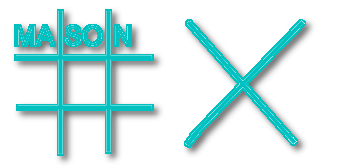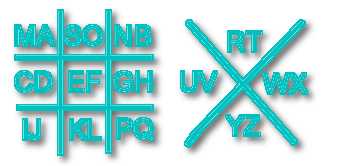This "monospace" font is for use in MS Windows. The graphic symbol set may be typed in MS Word by choosing Insert/Symbol/(normal text) from the program menu, or by using MS Word special characters Alt+Ctrl-? through Alt+`-U, which correspond with ANSI symbol keys Alt+0191 through Alt+0249. |
You may download a copy of this Masonic font for your use by clicking on the following link. FAM-Code.ZIP |
Masonic Cipher & Symbols© contains the Masonic "poundex" substitution cipher characters in upper and lower case, as well as the numerals and a complete set of common punctuation marks (not shown). The symbol set includes the jewels of the officer line and all the symbolic emblems explicated in the three Degrees of Blue Lodge Masonry (F&AM of California), except the very most esoteric. |
There are two related versions of the Masonic cipher. The version used here is that explained informally to Blue Lodge members, and is not an official part of any authentic Masonic teachings in the Grand Lodge of California. The other is sometimes taught in Royal Arch Masonry, and differs in that the first half of the alphabet (A-M) is assigned to the plain outlines, while the second half (N-Z) are the dotted characters. It should be noted that as simple "substitution ciphers" neither provides more than a superficial cryptographic security. |
The security afforded by this cipher is enhanced somewhat by combining it with a simple, separately communicated keyword, as follows:
M =
|


 H =
H =
 X =
X = ,
etc.
,
etc.